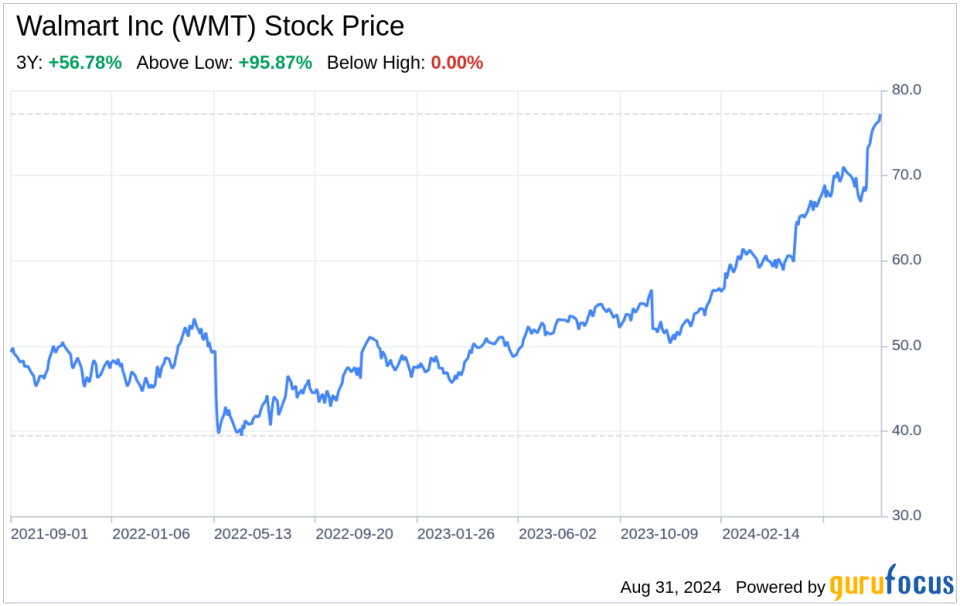Decoding Walmart Inc (WMT): A Strategic SWOT Insight
Walmart Inc (NYSE:WMT) showcases robust operating efficiency with significant net sales growth.
Despite a strong balance sheet, Walmart faces challenges in a highly competitive retail landscape.
Opportunities for Walmart include e-commerce expansion and omni-channel initiatives.
Threats include economic volatility, supply chain disruptions, and intense competition.
On August 30, 2024, Walmart Inc (NYSE:WMT) filed its 10-Q report, revealing a financial landscape that investors and market analysts keenly scrutinize. As the leading retailer in the United States, Walmart's strategy of offering the lowest priced goods to drive traffic and product turnover has been a cornerstone of its success. The latest filing indicates a year-over-year increase in net sales from $160,280 million to $167,767 million for the three months ended July 31, 2024, and from $311,284 million to $327,705 million for the six months ended. However, consolidated net income attributable to Walmart has seen a decline from $7,891 million to $4,501 million for the three months ended, and a slight increase from $9,564 million to $9,605 million for the six months ended. This mixed financial performance sets the stage for a detailed SWOT analysis to understand Walmart's current position and future prospects.

Strengths
Market Dominance and Brand Power: Walmart Inc (NYSE:WMT) continues to assert its dominance in the retail sector, with a staggering $167,767 million in net sales for the three months ended July 31, 2024. This figure not only underscores the company's strong brand recognition but also reflects its ability to maintain a loyal customer base despite economic fluctuations. Walmart's brand power is further evidenced by its expansive store count, with over 4,600 stores in the United States and more than 10,000 globally, serving approximately 240 million customers each week. The company's strategy of low pricing and one-stop shopping convenience has solidified its market position, making it a formidable force in the industry.
Financial Resilience and Operating Efficiency: Walmart's financial resilience is evident in its robust balance sheet and consistent revenue growth. The company's operating income stands at $7,940 million for the three months ended July 31, 2024, reflecting its superior operating efficiency. Walmart's ability to generate significant cash flows from operations allows it to invest in growth initiatives while also returning value to shareholders through dividends, as indicated by the declared dividends per common share of $0.83 for the six months ended. This financial strength enables Walmart to navigate market challenges and invest in strategic opportunities to drive future growth.
Weaknesses
Declining Net Income: Despite its strong sales figures, Walmart Inc (NYSE:WMT) has experienced a notable decline in consolidated net income, from $7,891 million to $4,501 million for the three months ended July 31, 2024. This decrease raises concerns about the company's profitability and the potential impact of rising costs, including those related to supply chain disruptions and increased competition. The decline in net income may also reflect margin pressures in certain product categories, necessitating a closer examination of Walmart's cost management and pricing strategies to ensure long-term profitability.
Competitive Pressures and Market Saturation: Walmart operates in an intensely competitive retail landscape, where it must continuously innovate to retain its market share. The company faces competition from both traditional brick-and-mortar retailers and e-commerce giants, which can erode its customer base and pressure margins. Additionally, with a high degree of market saturation in the United States, Walmart's opportunities for domestic expansion are limited, prompting the need for strategic international growth and diversification of its business model to sustain its competitive edge.
Opportunities
E-commerce Expansion and Omni-Channel Initiatives: Walmart Inc (NYSE:WMT) has significant opportunities to grow its e-commerce platform and enhance its omni-channel capabilities. With net sales related to e-commerce amounting to approximately $18.9 billion for Walmart U.S. for the three months ended July 31, 2024, the company is well-positioned to capitalize on the increasing trend of online shopping. By further integrating its physical and digital operations, Walmart can offer a seamless shopping experience, driving customer engagement and sales growth across multiple channels.
International Growth and Diversification: Walmart's international segment presents a vast opportunity for expansion and diversification. With operations in various countries and a contribution of $115 billion in sales, Walmart can leverage its global presence to tap into emerging markets and cater to a diverse customer base. By tailoring its product offerings and marketing strategies to local preferences, Walmart can drive international sales and reduce its reliance on the mature U.S. market, thereby fueling overall growth.
Threats
Economic Volatility and Consumer Behavior: Walmart Inc (NYSE:WMT) faces threats from economic volatility, including inflationary trends and shifts in consumer behavior. Economic uncertainties can affect consumer spending patterns, leading to reduced demand for Walmart's products. Additionally, fluctuations in currency exchange rates can impact the company's international earnings, posing a risk to its financial stability. Walmart must remain agile in its pricing and inventory management to respond to these economic challenges and maintain its value proposition to customers.
Supply Chain Disruptions and Competitive Landscape: Supply chain disruptions pose a significant threat to Walmart's operations, potentially leading to stockouts, increased costs, and customer dissatisfaction. Moreover, the competitive landscape in the retail sector is intensifying, with new entrants and existing players expanding their offerings and digital capabilities. To mitigate these threats, Walmart must continue to invest in supply chain resilience and innovation, ensuring it can meet customer demands efficiently and
This article, generated by GuruFocus, is designed to provide general insights and is not tailored financial advice. Our commentary is rooted in historical data and analyst projections, utilizing an impartial methodology, and is not intended to serve as specific investment guidance. It does not formulate a recommendation to purchase or divest any stock and does not consider individual investment objectives or financial circumstances. Our objective is to deliver long-term, fundamental data-driven analysis. Be aware that our analysis might not incorporate the most recent, price-sensitive company announcements or qualitative information. GuruFocus holds no position in the stocks mentioned herein.
This article first appeared on GuruFocus.
